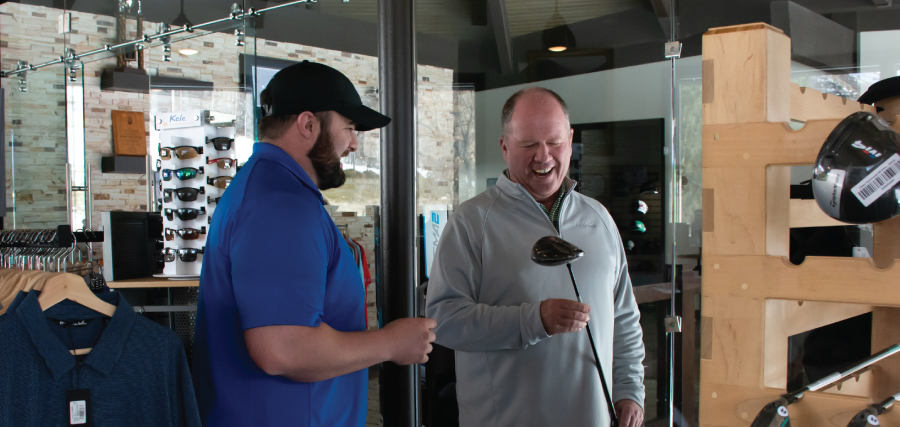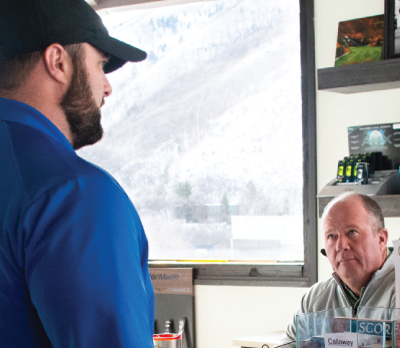Golfers, by and large, love people.
The social aspect of golf is something that draws your players to the game. They love the chance to spend 3-4 hours on the course with their friends and business partners. Pros love to spend time playing and teaching customers. And, everyone seems to enjoy the small interactions that happen throughout the clubhouse. It’s a social game, built around relationships and experiences.
So it stands to reason that social interactions or “face time” can make or break your course. Fortunately, there are several things you can keep in mind in order to make a fantastic interactions with your customers.
Improving “Face Time” With Your Guests
Note their conversational style
Every person communicates differently. Factors like geographic location, culture, social circles, upbringing, gender, career path, and age are all involved in creating each of our unique communication styles. Understanding small nuances of these styles can have an effect on how well you and your team are able to engage with customers of all demographics.
Gender communication tip
When dealing with someone of another gender, it’s beneficial to consid er stereotypical differences in ways we interact. Commonly, women are expected to downplay themselves, and do so much more frequently than men. When a woman downplays herself, it’s not necessarily an admission of inferiority. While you don’t need to go overboard, don’t allow her self-criticism to stop you from praising and complimenting. Men, however, typically feel as though they’re expected to do the opposite. They’re expected to be great, all of the time. If a man (or woman) is in the clubhouse or on the course trying to save face, just roll with it and encourage them. Remember, too, that if men become combative it’s often not personally motivated, but rather concern about being perceived as weak.
er stereotypical differences in ways we interact. Commonly, women are expected to downplay themselves, and do so much more frequently than men. When a woman downplays herself, it’s not necessarily an admission of inferiority. While you don’t need to go overboard, don’t allow her self-criticism to stop you from praising and complimenting. Men, however, typically feel as though they’re expected to do the opposite. They’re expected to be great, all of the time. If a man (or woman) is in the clubhouse or on the course trying to save face, just roll with it and encourage them. Remember, too, that if men become combative it’s often not personally motivated, but rather concern about being perceived as weak.
A note about pauses
Pauses in conversation can be valuable, even if they are uncomfortable for some of us. Ignoring the need to insert pauses into your conversation can turn many people off; we tend to get frustrated if we feel like we can’t jump into a conversation. Preference here often has to do with where we are raised, but to be safe it’s a good idea to take a look at how willing you are to let people get a word in edgewise.
For example, Bob from Detroit thinks Joe from NYC doesn’t want to hear what he has to say, because Joe doesn’t pause long enough to give Bob an opportunity to jump in. But, Joe keeps detecting awkward pauses in the conversation and feels the need to fill it in. Bob might get increasingly frustrated, while Joe thinks that they are having a great time.
To help your customers, no matter where they’re from, make sure you allow sufficient time for them to respond.
Practice “Active Listening”
In the customer service industry, there’s probably no truism more repeated than “Listen to your customers,” but what that exactly means isn’t always so clear. Sometimes it seems like we’ve done an excellent job of listening, and then find out the other person thought we were completely disinterested. How do we bridge that gap?
customer service industry, there’s probably no truism more repeated than “Listen to your customers,” but what that exactly means isn’t always so clear. Sometimes it seems like we’ve done an excellent job of listening, and then find out the other person thought we were completely disinterested. How do we bridge that gap?
One way is to make sure that the other person feels heard, and you can do that through what’s called “active listening.”
Ask for clarification.
Nodding assent and saying “yes” are a good place to start, but communication is a two-way street. If your customer says something you don’t understand, be sure to ask them what they meant by that (during an appropriate pause, of course).
For example, if a customer says, “I don’t feel like things always happen very quickly,” you can ask them, “What things are you referring to?”
Reflecting
“Reflecting” is a way to help your customers feel that you understand. This involves paraphrasing long comments or monologues back to them in your own words. Start by trying to repeat their point back to them in your own words. You can begin your paraphrase with a statement like “So what I’m hearing is…” or “It sounds like you’re saying…”
Watch Your Language
Most of the things that you shouldn’t do to customers (swear or yell at them, etc.) are pretty obvious, so instead we’ll focus on language you can implement to create a better guest experience.
Be overly clear.
It’s simple to ask questions in a way that will motivate the customer to respond. For example, asking for their license with a distracted request of “ID?” is much less engaging (and courteous) than stopping to look them in the eye and asking “May I see your ID please?”
This is a small change, but it can make a big difference in the customer’s perception of your interaction, and therefore your business.
Turn the statement positive.
Customers want to hear what you can do to help them, rather than what you can’t do. Instead of saying, “I can’t give you a refund unless I get your credit card number,” you can say, “I can get you a full refund if you allow me to have your credit card number.”
This makes the customer feel like you are always helping them, even if ultimately there is nothing you can do.
It’s not about you.
Some words and phrases can make the customer feel defensive without you even knowing. For example, saying, “You have to speak louder” can make a customer upset that you aren’t listening, but saying “I’m having a hard time hearing you” will gently push them to raise their volume.
Communication is Key
When it comes down to it, the most important thing in making the most of your time with your guests is intentional communication. Of course, you’ll always have the odd customer who just can’t be pleased, but on the whole, if you implement the suggestions above, then your customers will be amazed with your course.
Source:
https://hbr.org/1995/09/the-power-of-talk-who-gets-heard-and-why
